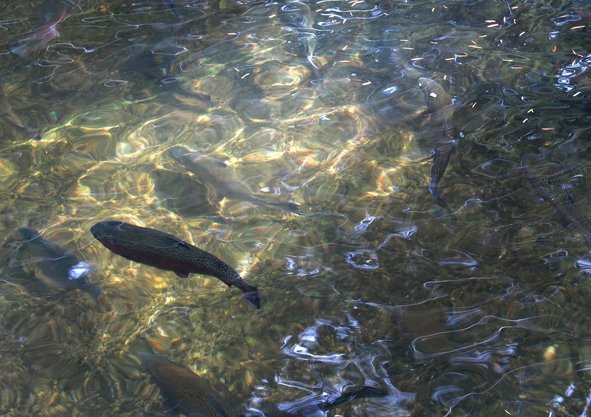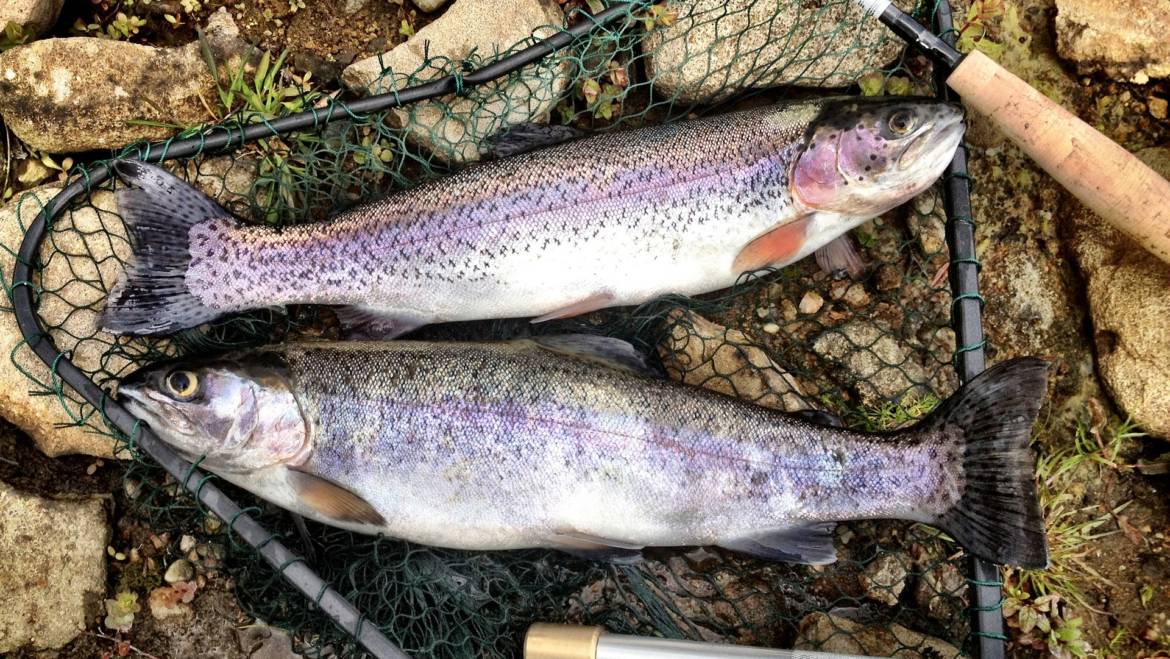Known for their tail-walking acrobats, rainbow trout are a treat for fishermen. Rainbow trout are a colorful fish with pink to red stripes on their bodies. If you are new to trout fishing, you may find catching rainbow trout to be challenging because of their sharp senses and playful nature. Be prepared for a battle right up to the net when catching these fish.
There’s no need to worry, though. In this guide, we cover some simple tips for beginners on how to catch rainbow trout.
But before we share our professional fishing tips with you, let’s learn more about rainbow trout habitat, appearance, and feeding habits. The better you understand the fish, the easier you will find catching them.
Rainbow Trout Appearance
Rainbow trout have an elongated body with a round or elongated snot. Male rainbow trout fish have an elongated snout, while the female trout have a short-rounded snout.
The average rainbow trout size is about 16 inches in length and up to 8 pounds in weight. You can also find rainbow trout sizes of 12 to 30 inches.
The upper sides of the rainbow trout fish are blue-green, steel-blue, or yellow-blue color, while the lower sides are pale yellow-green to grey, and are marked with pinkish-blue to red patterns.

A species of rainbow trout is the golden rainbow trout that have a distinct bright-yellow color body. The Golden rainbow trout has the same size and feeding habits as the typical rainbow trout as well as the distinct pink-reddish stripe.
Rainbow trout undergo changes in color and anatomy as they become mature. Their exterior surface changes from silvery color to bright pink, red, and green. Male trout also develop a hooked jaw known as kype, while the female snout becomes stouter and rounder with age.
Rainbow Trout Habitat
Rainbow trout (scientific name: Oncorhynchus mykiss) are a species of salmonids that thrive in freshwater lakes and clear mountain streams with gravel bottoms. The fish are commonly found in cool water (50-60 0F or 10-16 0C), but some strains also are found in warmer waters to the south.
Interesting Fact: Rainbow trout found in Great Lakes and Oceans are larger and are known as ‘steel-heads’. Click here to learn more about the difference between rainbow trout and steelhead trout.
What Do Rainbow Trout Eat?
Rainbow trout are predators that will eat anything in the water, including small fishes, insects, and fish eggs. Rainbow trout diet includes other small rainbow trout, and scavenge the remains of dead fish. But the most common food source of the fish is insects like worms, dragonflies, damselflies, mayflies, and caddies flies.
Important Tip: Always have a variety of baits with you when fishing rainbow trout. You will never know what bait will click with the fish. Sometimes, they ignore certain food options and fall for specific bait.
Rainbow trout have sharp teeth on the roof of the mouth. They will eat until full and not eat anything until their food has fully digested and they become hungry again. Their preference during the second feeding bout is usually another food source unless the food supply in the river or lake is limited.
How to catch rainbow trout

Rainbow Trout Rig
You should bring the right gear to catch rainbow trout. Consider buying the lightest line you can get as rainbow trout have sharp senses. The fish often stay away from the bait if the line is too visible. Make sure to buy an ultra light spinning rod that is between 4 to 6 feet long.
A light-duty spin casting reel with a 4 pounds test line is also recommended. You can also buy regular-sized (#11 to #14) bronze hooks for fishing rainbow trout. If you are fishing in swift water, you can buy a small split shot and canvas creel.
Rainbow Trout Bait
Rainbow trout fish enjoy a varied diet. While you will do some guessing when selecting rainbow trout bait, it is advisable to check out the food sources available at a nearby lake. This will increase your chances of successfully selecting the right food source for the fish.
A good practice is to keep a logbook with you when fishing. You can note down which bait works in catching a fish. This will help you to select the most effective bait for catching rainbow trout.
Rainbow Trout Lures
You need to pick rainbow trout lures wisely. Selecting the wrong lures can result in lost opportunities and a waste of time. We suggest the following lures to successfully catch the rainbow trout.
- Swimbaits
- Critters
- Cranks
- Tubes
- Salmon Eggs
- Flashy spoons tipped with feather
- Spinners and Rooster Tails
- Worm Imitators
Rainbow Trout Fishing Tips
Catching rainbow trout can be hard. With our rainbow trout fishing tips, you will know what it takes to catch these fish that are highly prized among trout fishermen.

Trout Fishing in Rivers
Golden trout are mostly found in slow-moving rivers. The fish generally don’t swim in fast-flowing rivers as it would tire them out. They wait to ambush their prey below the current or outside it, such as behind large rocks. You should try to make bait or lure similar to a stray fly or worm.
Deep rivers generally hold large size trout. The Naknek and the Kvichak rivers in Alaska have some of the largest rainbow trout. You can found trophy rainbow trout in these waters, particularly during dawn and dusk.
If you’re new to rainbow trout fishing in rivers, we recommend checking out this page!
Trout Fishing in Lakes
Rainbow trout fishing in lakes is a bit challenging. Start at the lake’s end that has a moving stream as it’s is the most common place that trout tend to congregate. The fish are normally found above the aquatic vegetation in the lakes.
You can also find rainbow trout around stumps, rocks, logs, and other structures where streams that flow into the lakes most likely bring a supply of food.
Pick the Bait Wisely
Try to lure the fishes using appropriate bait. If you are not successful, try the bait again in another promising location.
Keep an eye on the trout’s activities, such as chasing or rising to eat the bait. If a trout becomes interested in the lure but does not eat it, you can try the same bait in another place. A lure may be effective but a trout won’t chase it if it perceives a threat. You should try it at another spot to catch the fish.
Do not use PowerBaits for catching wild rainbow trouts. Native trout won’t take a bite of the PowerBait. PowerBaits work well for stocked or farm-raised trouts. Fish farmers mostly feed pellets to stocked trout. So, the trout that are raised in the hatchery are attracted to PowerBaits as they appear similar to pellets.
The best time for Rainbow Trout Fishing
The best time to fish for trout in lakes is the fall and spring seasons. Rainbow trout are found in deep, cooler waters during the warm summer months where they are difficult to catch.
In states along the coast, the best time for trout fishing is during the winters. But this is not recommended unless you want to brave wet and cold weather to catch trout.
Know the Right Technique

You can apply different techniques for fishing in ponds, lakes, and rivers. For fishing in lakes and ponds, the best method is to fish with the bait at the bottom. You should use a lead weight attached about one and a half feet above the hook containing the bait.
Another method to fish for rainbow trout in lakes is to suspend fish bait under the bobber. Hook the bait and attack a lead weight and a bobber about 3 feet about the hook. You should cast it out to a likely spot on the lake and wait for the fish to take a bite.
The best technique for fishing in rivers is by casting a spoon or spinner slightly upriver. The fishing line should be held off the water to achieve a drift. Slowly retrieve the reel once the spinner is facing the shore in a straight direction downriver.
Rainbow Trout Fly Fishing
Rainbow trout fly fishing is a popular fishing method used by professional trout fishers. The method is mostly used for fishing in rivers with fast-moving water. It involves tying a fly on the end of a line and casting the line with a spinning gear. You will then slowly retrieve the line back so that it appears to the fish that the fly is drifting along.
A difficult part about fly fishing is that the fish will bite and then spit out the bait. So, you need to be very quick once the fish takes a bit of the bait. Fly fishing is a complex yet effective tactic that we will cover in detail in one of our other articles.
For more tips on catching rainbow trout fishing, you can watch the video below.
Conclusion
Rainbow trout fishing is not easy, especially if you are starting out. The information in this guide has given you an idea of the best way to catch rainbow trout. You will need to devise your own game plan based on what works. Happy fishing!






